2014 FORD F SERIES MOTORHOME AND COMMERCIAL CHASSIS transmission
[x] Cancel search: transmissionPage 4 of 143
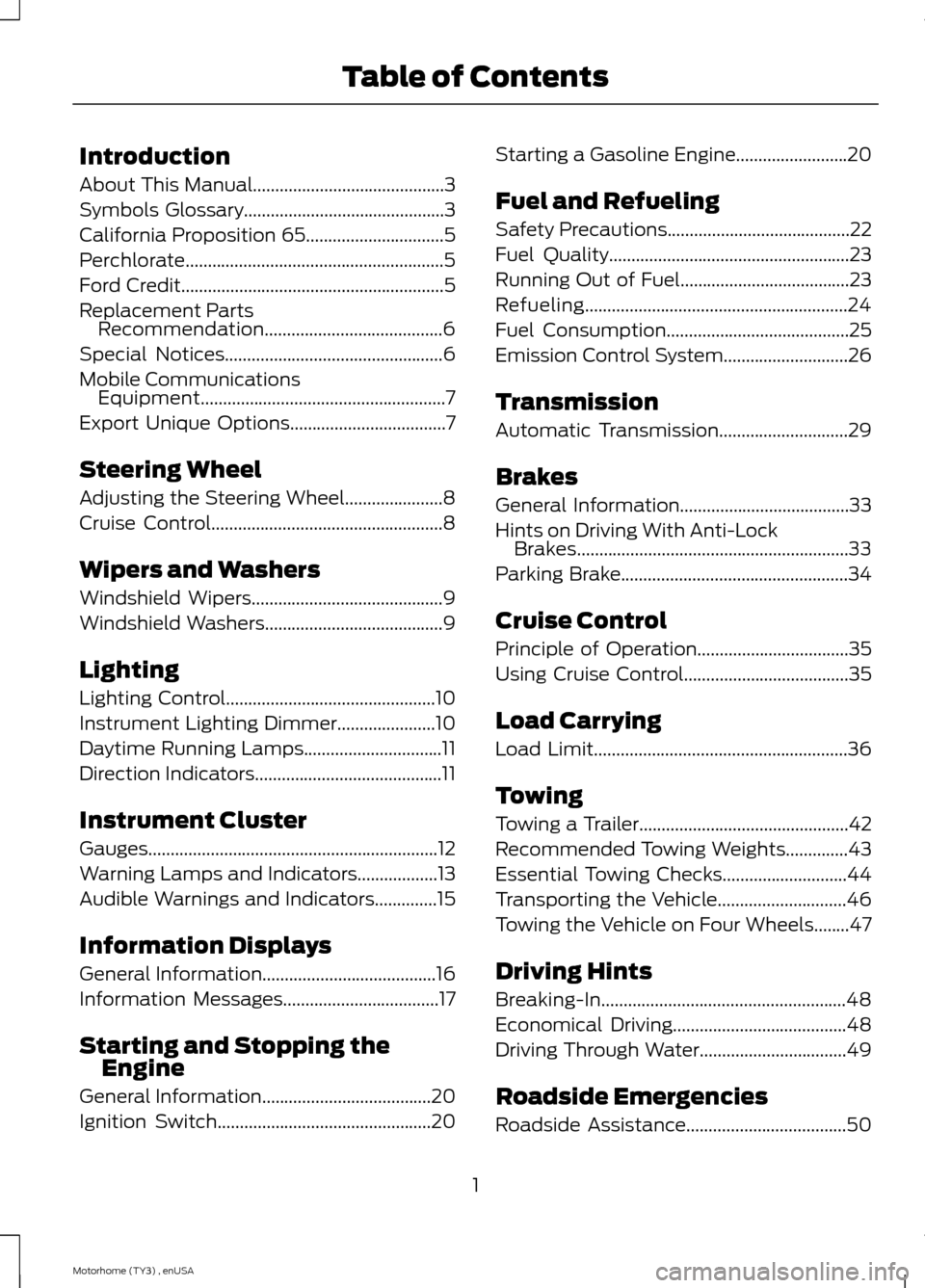
Introduction
About This Manual...........................................3
Symbols Glossary.............................................3
California Proposition 65...............................5
Perchlorate..........................................................5
Ford Credit...........................................................5
Replacement PartsRecommendation........................................6
Special Notices.................................................6
Mobile CommunicationsEquipment.......................................................7
Export Unique Options...................................7
Steering Wheel
Adjusting the Steering Wheel......................8
Cruise Control....................................................8
Wipers and Washers
Windshield Wipers...........................................9
Windshield Washers........................................9
Lighting
Lighting Control...............................................10
Instrument Lighting Dimmer......................10
Daytime Running Lamps...............................11
Direction Indicators..........................................11
Instrument Cluster
Gauges.................................................................12
Warning Lamps and Indicators..................13
Audible Warnings and Indicators..............15
Information Displays
General Information.......................................16
Information Messages...................................17
Starting and Stopping theEngine
General Information......................................20
Ignition Switch................................................20
Starting a Gasoline Engine.........................20
Fuel and Refueling
Safety Precautions.........................................22
Fuel Quality......................................................23
Running Out of Fuel......................................23
Refueling...........................................................24
Fuel Consumption.........................................25
Emission Control System............................26
Transmission
Automatic Transmission.............................29
Brakes
General Information......................................33
Hints on Driving With Anti-LockBrakes.............................................................33
Parking Brake...................................................34
Cruise Control
Principle of Operation..................................35
Using Cruise Control.....................................35
Load Carrying
Load Limit.........................................................36
Towing
Towing a Trailer...............................................42
Recommended Towing Weights..............43
Essential Towing Checks............................44
Transporting the Vehicle.............................46
Towing the Vehicle on Four Wheels........47
Driving Hints
Breaking-In.......................................................48
Economical Driving.......................................48
Driving Through Water.................................49
Roadside Emergencies
Roadside Assistance....................................50
1Motorhome (TY3) , enUSATable of Contents
Page 5 of 143
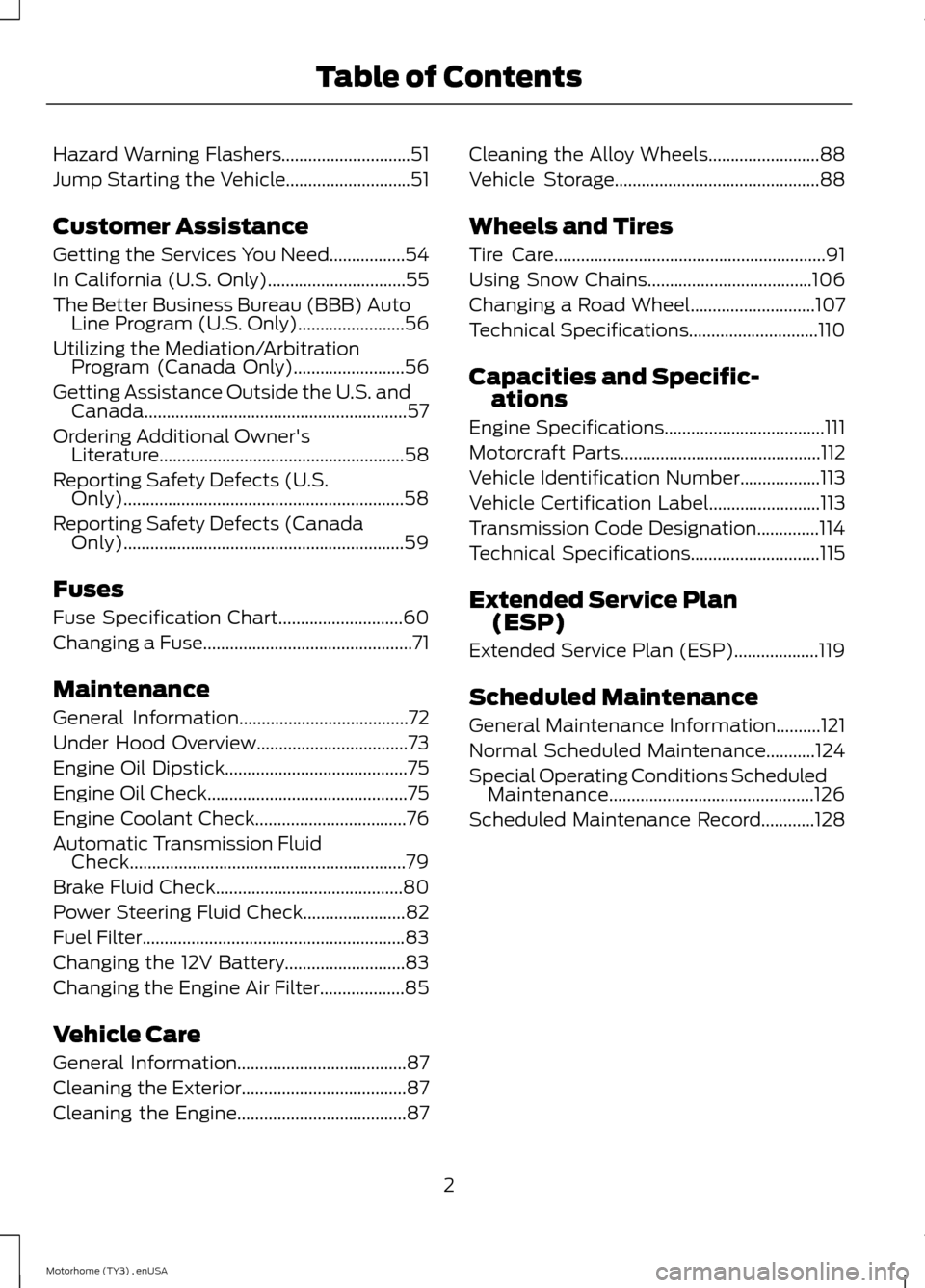
Hazard Warning Flashers.............................51
Jump Starting the Vehicle............................51
Customer Assistance
Getting the Services You Need.................54
In California (U.S. Only)...............................55
The Better Business Bureau (BBB) AutoLine Program (U.S. Only)........................56
Utilizing the Mediation/ArbitrationProgram (Canada Only).........................56
Getting Assistance Outside the U.S. andCanada...........................................................57
Ordering Additional Owner'sLiterature.......................................................58
Reporting Safety Defects (U.S.Only)...............................................................58
Reporting Safety Defects (CanadaOnly)...............................................................59
Fuses
Fuse Specification Chart............................60
Changing a Fuse...............................................71
Maintenance
General Information......................................72
Under Hood Overview..................................73
Engine Oil Dipstick.........................................75
Engine Oil Check.............................................75
Engine Coolant Check..................................76
Automatic Transmission FluidCheck..............................................................79
Brake Fluid Check..........................................80
Power Steering Fluid Check.......................82
Fuel Filter...........................................................83
Changing the 12V Battery...........................83
Changing the Engine Air Filter...................85
Vehicle Care
General Information......................................87
Cleaning the Exterior.....................................87
Cleaning the Engine......................................87
Cleaning the Alloy Wheels.........................88
Vehicle Storage..............................................88
Wheels and Tires
Tire Care.............................................................91
Using Snow Chains.....................................106
Changing a Road Wheel............................107
Technical Specifications.............................110
Capacities and Specific-ations
Engine Specifications....................................111
Motorcraft Parts.............................................112
Vehicle Identification Number..................113
Vehicle Certification Label.........................113
Transmission Code Designation..............114
Technical Specifications.............................115
Extended Service Plan(ESP)
Extended Service Plan (ESP)...................119
Scheduled Maintenance
General Maintenance Information..........121
Normal Scheduled Maintenance...........124
Special Operating Conditions ScheduledMaintenance..............................................126
Scheduled Maintenance Record............128
2Motorhome (TY3) , enUSATable of Contents
Page 15 of 143
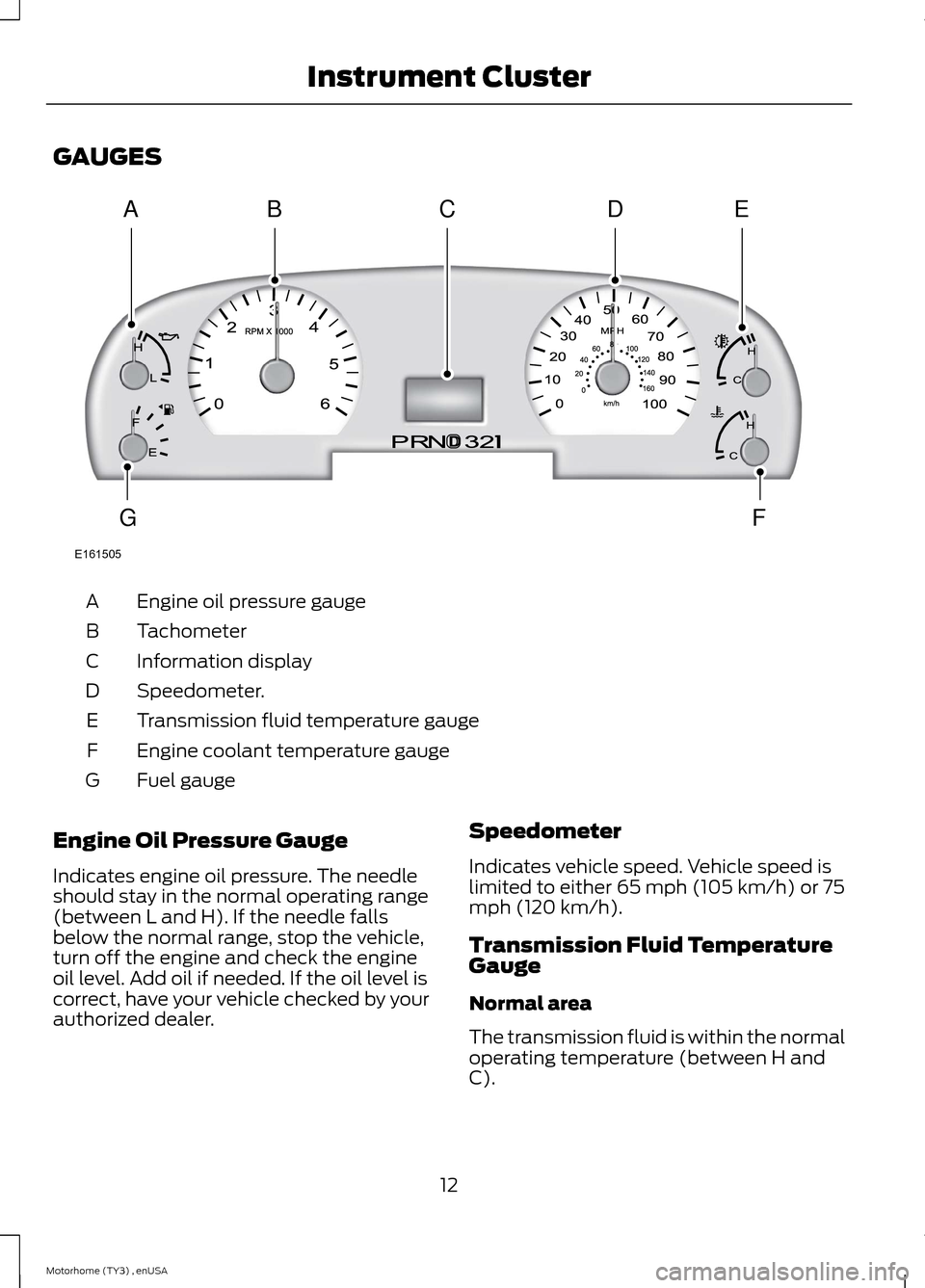
GAUGES
Engine oil pressure gaugeA
TachometerB
Information displayC
Speedometer.D
Transmission fluid temperature gaugeE
Engine coolant temperature gaugeF
Fuel gaugeG
Engine Oil Pressure Gauge
Indicates engine oil pressure. The needleshould stay in the normal operating range(between L and H). If the needle fallsbelow the normal range, stop the vehicle,turn off the engine and check the engineoil level. Add oil if needed. If the oil level iscorrect, have your vehicle checked by yourauthorized dealer.
Speedometer
Indicates vehicle speed. Vehicle speed islimited to either 65 mph (105 km/h) or 75mph (120 km/h).
Transmission Fluid TemperatureGauge
Normal area
The transmission fluid is within the normaloperating temperature (between H andC).
12Motorhome (TY3) , enUSAInstrument ClusterE161505ABDECGF
Page 16 of 143
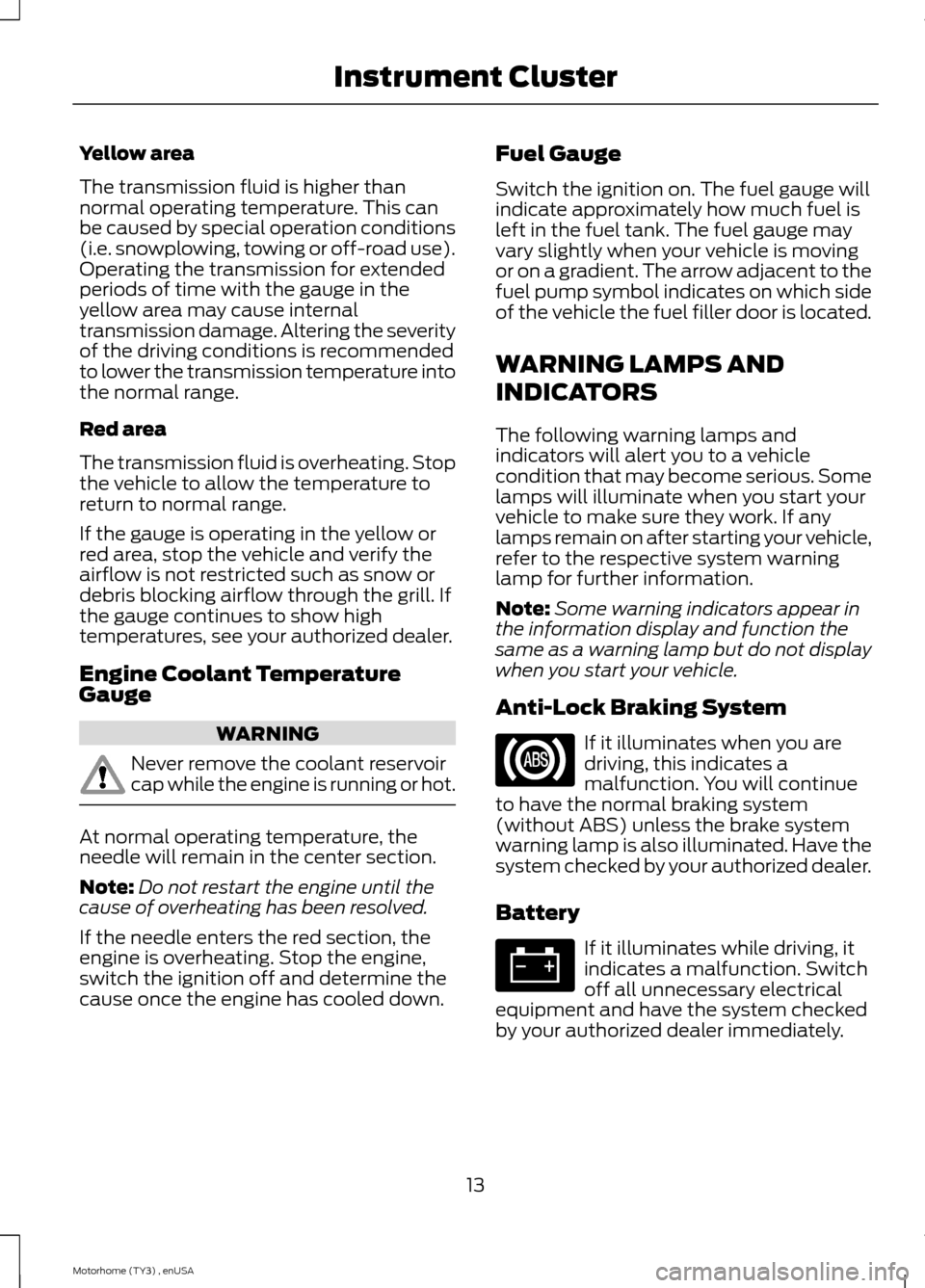
Yellow area
The transmission fluid is higher thannormal operating temperature. This canbe caused by special operation conditions(i.e. snowplowing, towing or off-road use).Operating the transmission for extendedperiods of time with the gauge in theyellow area may cause internaltransmission damage. Altering the severityof the driving conditions is recommendedto lower the transmission temperature intothe normal range.
Red area
The transmission fluid is overheating. Stopthe vehicle to allow the temperature toreturn to normal range.
If the gauge is operating in the yellow orred area, stop the vehicle and verify theairflow is not restricted such as snow ordebris blocking airflow through the grill. Ifthe gauge continues to show hightemperatures, see your authorized dealer.
Engine Coolant TemperatureGauge
WARNING
Never remove the coolant reservoircap while the engine is running or hot.
At normal operating temperature, theneedle will remain in the center section.
Note:Do not restart the engine until thecause of overheating has been resolved.
If the needle enters the red section, theengine is overheating. Stop the engine,switch the ignition off and determine thecause once the engine has cooled down.
Fuel Gauge
Switch the ignition on. The fuel gauge willindicate approximately how much fuel isleft in the fuel tank. The fuel gauge mayvary slightly when your vehicle is movingor on a gradient. The arrow adjacent to thefuel pump symbol indicates on which sideof the vehicle the fuel filler door is located.
WARNING LAMPS AND
INDICATORS
The following warning lamps andindicators will alert you to a vehiclecondition that may become serious. Somelamps will illuminate when you start yourvehicle to make sure they work. If anylamps remain on after starting your vehicle,refer to the respective system warninglamp for further information.
Note:Some warning indicators appear inthe information display and function thesame as a warning lamp but do not displaywhen you start your vehicle.
Anti-Lock Braking System
If it illuminates when you aredriving, this indicates amalfunction. You will continueto have the normal braking system(without ABS) unless the brake systemwarning lamp is also illuminated. Have thesystem checked by your authorized dealer.
Battery
If it illuminates while driving, itindicates a malfunction. Switchoff all unnecessary electricalequipment and have the system checkedby your authorized dealer immediately.
13Motorhome (TY3) , enUSAInstrument Cluster
Page 18 of 143
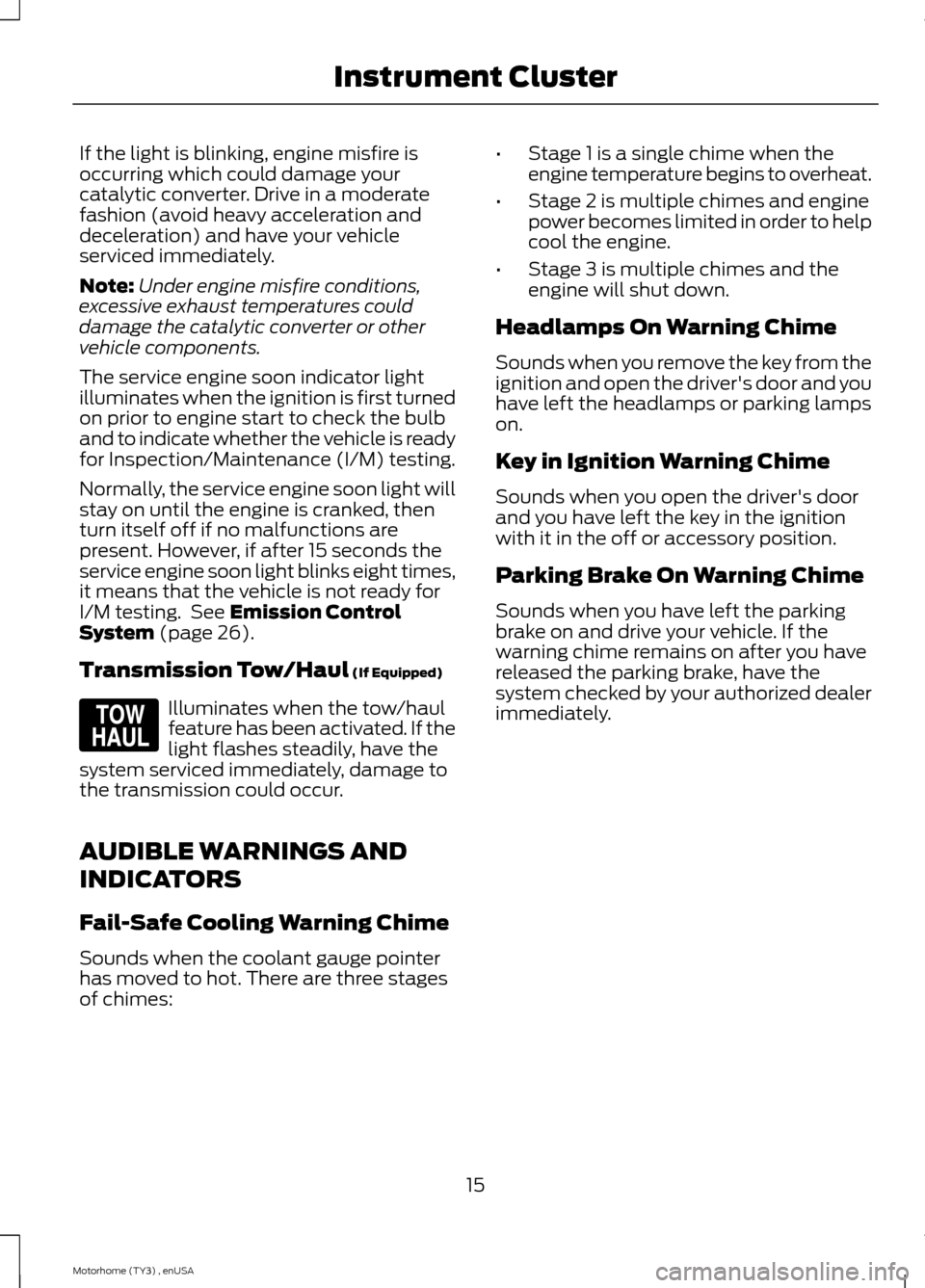
If the light is blinking, engine misfire isoccurring which could damage yourcatalytic converter. Drive in a moderatefashion (avoid heavy acceleration anddeceleration) and have your vehicleserviced immediately.
Note:Under engine misfire conditions,excessive exhaust temperatures coulddamage the catalytic converter or othervehicle components.
The service engine soon indicator lightilluminates when the ignition is first turnedon prior to engine start to check the bulband to indicate whether the vehicle is readyfor Inspection/Maintenance (I/M) testing.
Normally, the service engine soon light willstay on until the engine is cranked, thenturn itself off if no malfunctions arepresent. However, if after 15 seconds theservice engine soon light blinks eight times,it means that the vehicle is not ready forI/M testing. See Emission ControlSystem (page 26).
Transmission Tow/Haul (If Equipped)
Illuminates when the tow/haulfeature has been activated. If thelight flashes steadily, have thesystem serviced immediately, damage tothe transmission could occur.
AUDIBLE WARNINGS AND
INDICATORS
Fail-Safe Cooling Warning Chime
Sounds when the coolant gauge pointerhas moved to hot. There are three stagesof chimes:
•Stage 1 is a single chime when theengine temperature begins to overheat.
•Stage 2 is multiple chimes and enginepower becomes limited in order to helpcool the engine.
•Stage 3 is multiple chimes and theengine will shut down.
Headlamps On Warning Chime
Sounds when you remove the key from theignition and open the driver's door and youhave left the headlamps or parking lampson.
Key in Ignition Warning Chime
Sounds when you open the driver's doorand you have left the key in the ignitionwith it in the off or accessory position.
Parking Brake On Warning Chime
Sounds when you have left the parkingbrake on and drive your vehicle. If thewarning chime remains on after you havereleased the parking brake, have thesystem checked by your authorized dealerimmediately.
15Motorhome (TY3) , enUSAInstrument ClusterE161509
Page 22 of 143
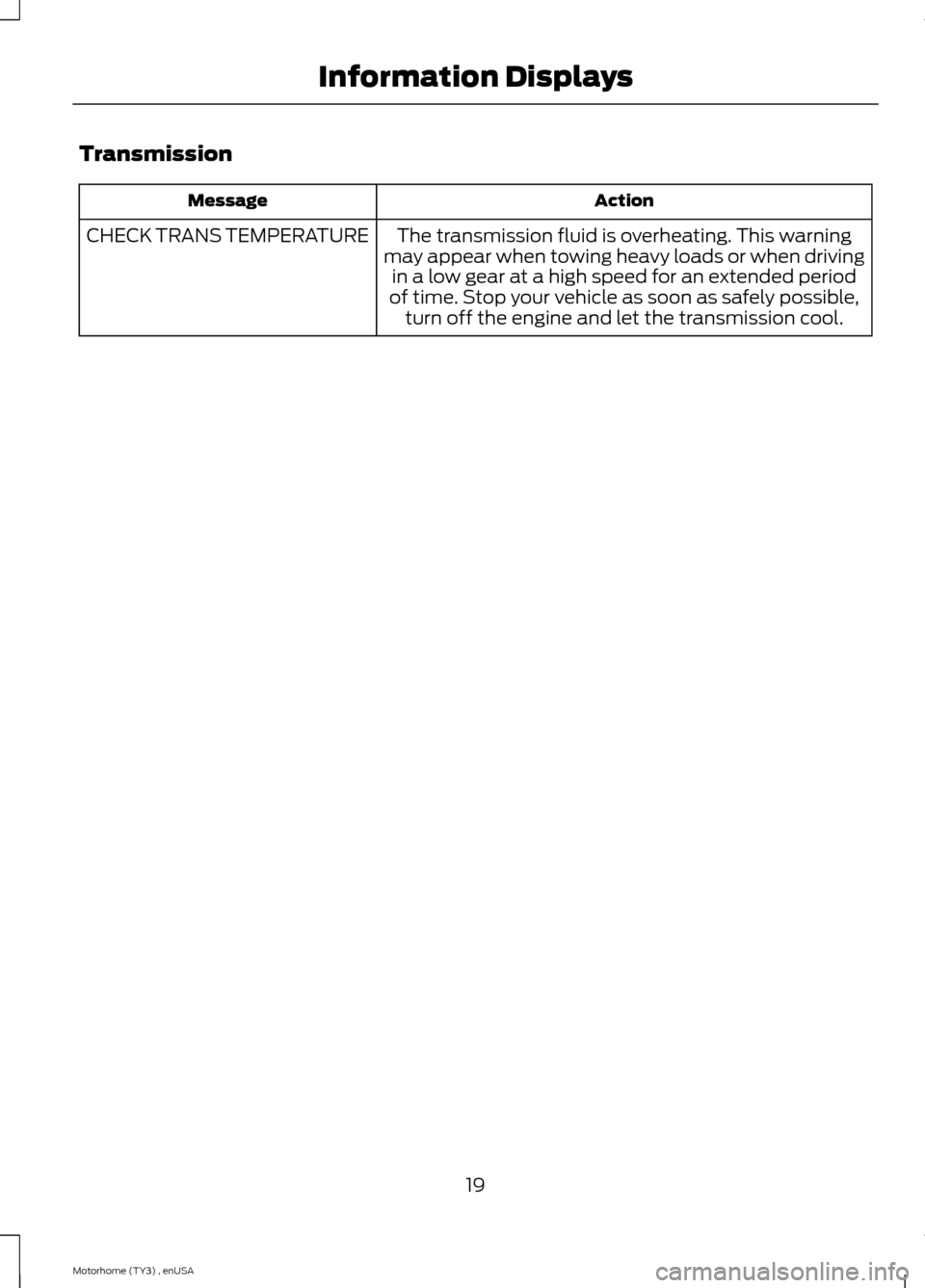
Transmission
ActionMessage
The transmission fluid is overheating. This warningmay appear when towing heavy loads or when drivingin a low gear at a high speed for an extended periodof time. Stop your vehicle as soon as safely possible,turn off the engine and let the transmission cool.
CHECK TRANS TEMPERATURE
19Motorhome (TY3) , enUSAInformation Displays
Page 24 of 143
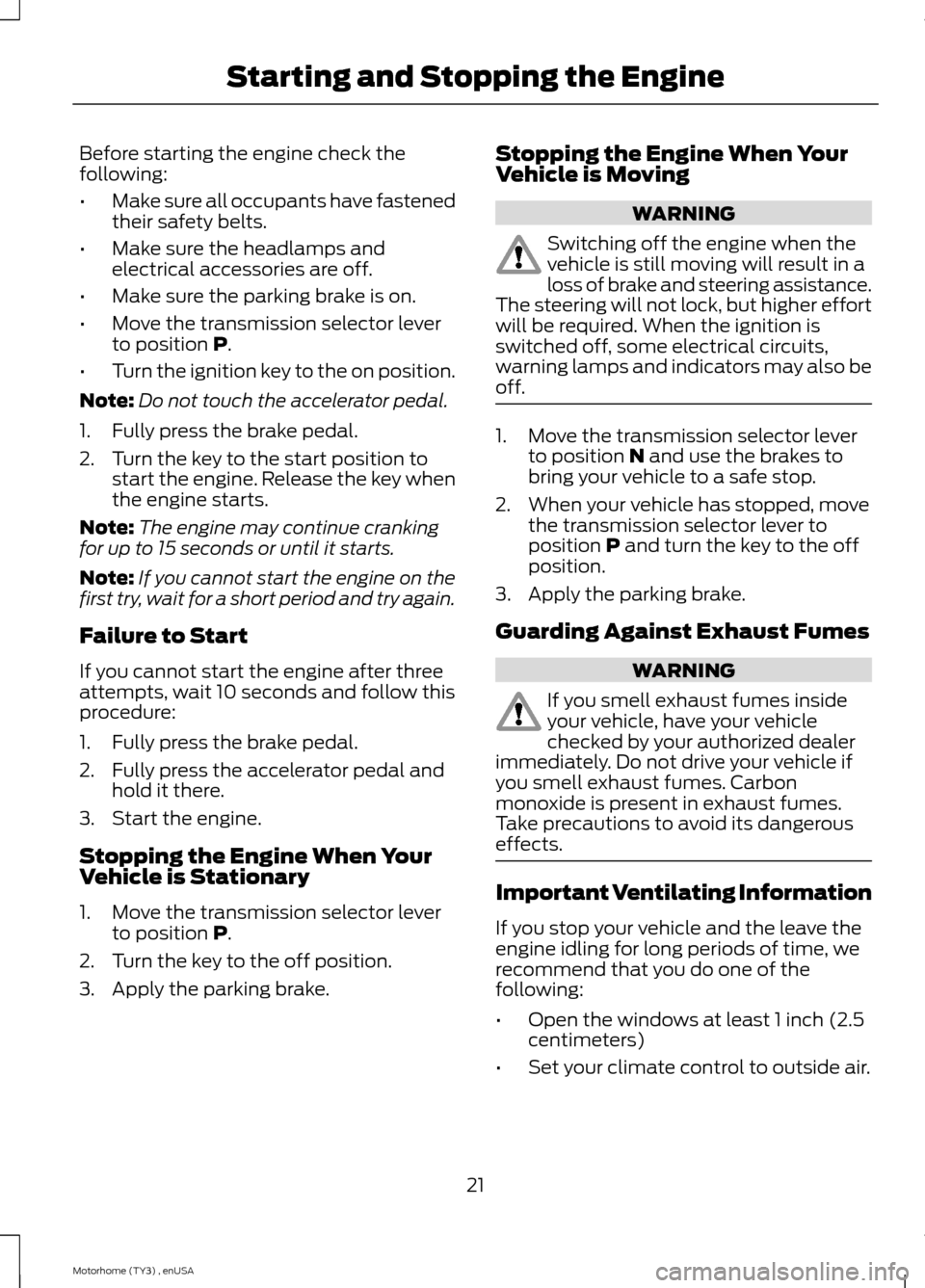
Before starting the engine check thefollowing:
•Make sure all occupants have fastenedtheir safety belts.
•Make sure the headlamps andelectrical accessories are off.
•Make sure the parking brake is on.
•Move the transmission selector leverto position P.
•Turn the ignition key to the on position.
Note:Do not touch the accelerator pedal.
1.Fully press the brake pedal.
2.Turn the key to the start position tostart the engine. Release the key whenthe engine starts.
Note:The engine may continue crankingfor up to 15 seconds or until it starts.
Note:If you cannot start the engine on thefirst try, wait for a short period and try again.
Failure to Start
If you cannot start the engine after threeattempts, wait 10 seconds and follow thisprocedure:
1.Fully press the brake pedal.
2.Fully press the accelerator pedal andhold it there.
3.Start the engine.
Stopping the Engine When YourVehicle is Stationary
1.Move the transmission selector leverto position P.
2.Turn the key to the off position.
3.Apply the parking brake.
Stopping the Engine When YourVehicle is Moving
WARNING
Switching off the engine when thevehicle is still moving will result in aloss of brake and steering assistance.The steering will not lock, but higher effortwill be required. When the ignition isswitched off, some electrical circuits,warning lamps and indicators may also beoff.
1.Move the transmission selector leverto position N and use the brakes tobring your vehicle to a safe stop.
2.When your vehicle has stopped, movethe transmission selector lever toposition P and turn the key to the offposition.
3.Apply the parking brake.
Guarding Against Exhaust Fumes
WARNING
If you smell exhaust fumes insideyour vehicle, have your vehiclechecked by your authorized dealerimmediately. Do not drive your vehicle ifyou smell exhaust fumes. Carbonmonoxide is present in exhaust fumes.Take precautions to avoid its dangerouseffects.
Important Ventilating Information
If you stop your vehicle and the leave theengine idling for long periods of time, werecommend that you do one of thefollowing:
•Open the windows at least 1 inch (2.5centimeters)
•Set your climate control to outside air.
21Motorhome (TY3) , enUSAStarting and Stopping the Engine
Page 29 of 143
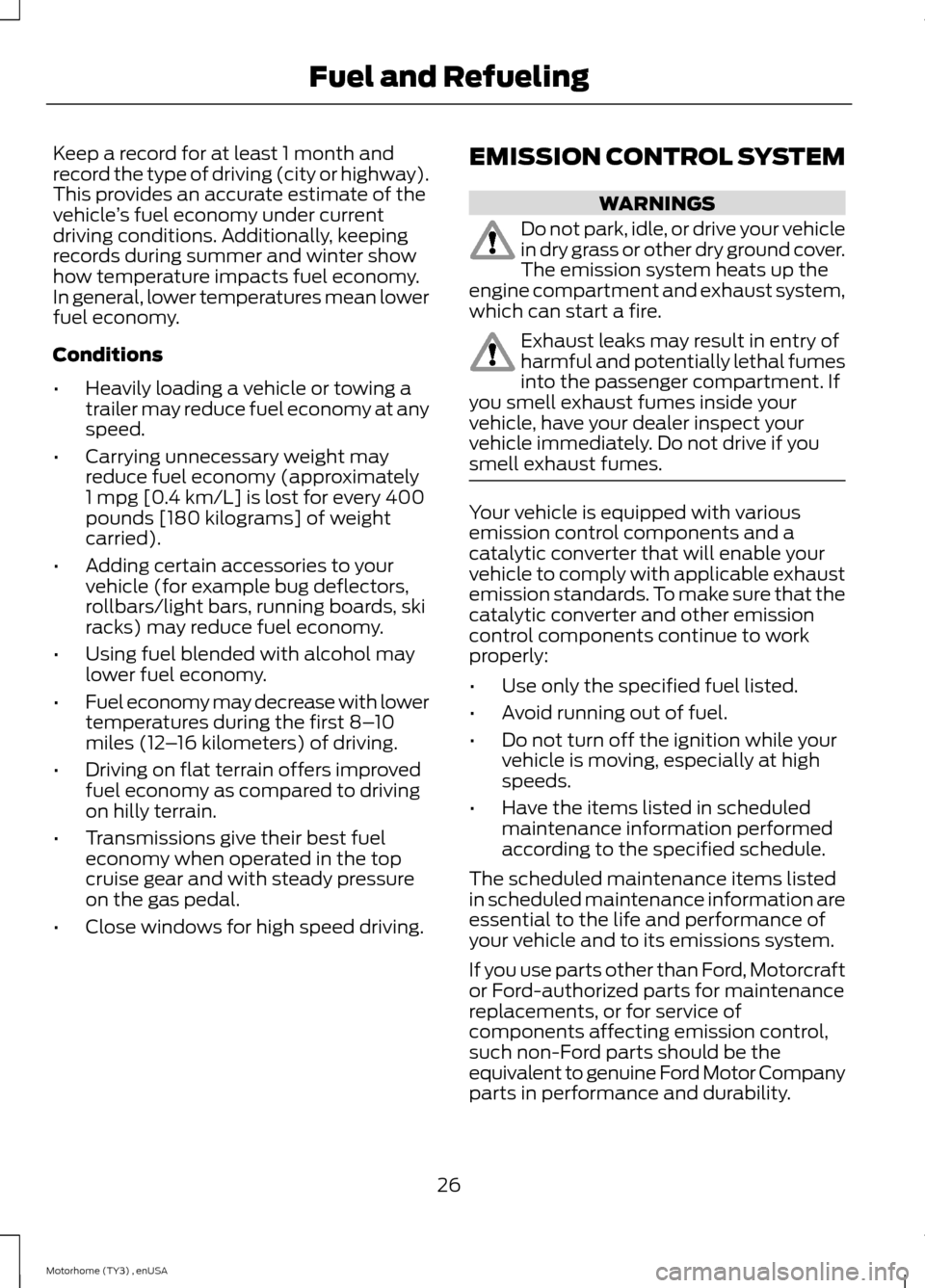
Keep a record for at least 1 month andrecord the type of driving (city or highway).This provides an accurate estimate of thevehicle’s fuel economy under currentdriving conditions. Additionally, keepingrecords during summer and winter showhow temperature impacts fuel economy.In general, lower temperatures mean lowerfuel economy.
Conditions
•Heavily loading a vehicle or towing atrailer may reduce fuel economy at anyspeed.
•Carrying unnecessary weight mayreduce fuel economy (approximately1 mpg [0.4 km/L] is lost for every 400pounds [180 kilograms] of weightcarried).
•Adding certain accessories to yourvehicle (for example bug deflectors,rollbars/light bars, running boards, skiracks) may reduce fuel economy.
•Using fuel blended with alcohol maylower fuel economy.
•Fuel economy may decrease with lowertemperatures during the first 8–10miles (12–16 kilometers) of driving.
•Driving on flat terrain offers improvedfuel economy as compared to drivingon hilly terrain.
•Transmissions give their best fueleconomy when operated in the topcruise gear and with steady pressureon the gas pedal.
•Close windows for high speed driving.
EMISSION CONTROL SYSTEM
WARNINGS
Do not park, idle, or drive your vehiclein dry grass or other dry ground cover.The emission system heats up theengine compartment and exhaust system,which can start a fire.
Exhaust leaks may result in entry ofharmful and potentially lethal fumesinto the passenger compartment. Ifyou smell exhaust fumes inside yourvehicle, have your dealer inspect yourvehicle immediately. Do not drive if yousmell exhaust fumes.
Your vehicle is equipped with variousemission control components and acatalytic converter that will enable yourvehicle to comply with applicable exhaustemission standards. To make sure that thecatalytic converter and other emissioncontrol components continue to workproperly:
•Use only the specified fuel listed.
•Avoid running out of fuel.
•Do not turn off the ignition while yourvehicle is moving, especially at highspeeds.
•Have the items listed in scheduledmaintenance information performedaccording to the specified schedule.
The scheduled maintenance items listedin scheduled maintenance information areessential to the life and performance ofyour vehicle and to its emissions system.
If you use parts other than Ford, Motorcraftor Ford-authorized parts for maintenancereplacements, or for service ofcomponents affecting emission control,such non-Ford parts should be theequivalent to genuine Ford Motor Companyparts in performance and durability.
26Motorhome (TY3) , enUSAFuel and Refueling